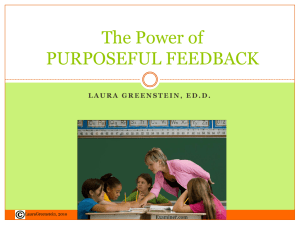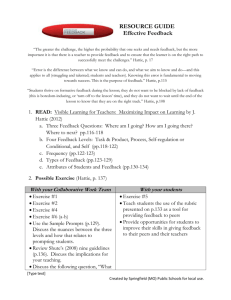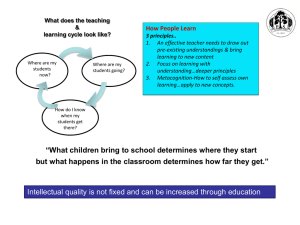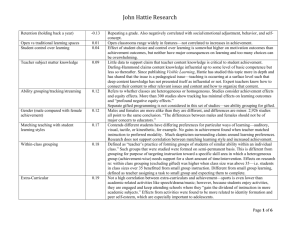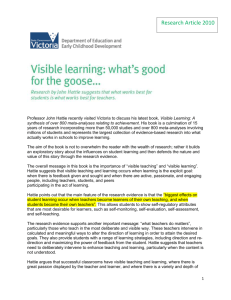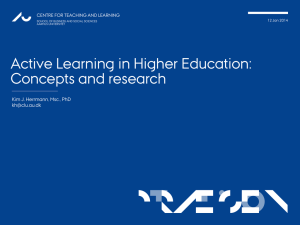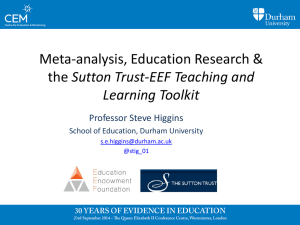Hattie – Visible Learning
advertisement
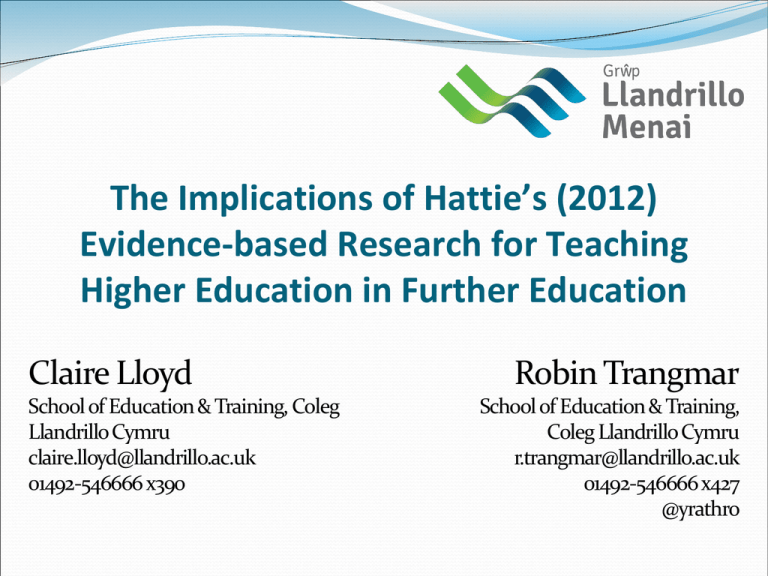
The Implications of Hattie’s (2012) Evidence-based Research for Teaching Higher Education in Further Education Claire Lloyd School of Education & Training, Coleg Llandrillo Cymru claire.lloyd@llandrillo.ac.uk 01492-546666 x390 Robin Trangmar School of Education & Training, Coleg Llandrillo Cymru r.trangmar@llandrillo.ac.uk 01492-546666 x427 @yrathro Aim of Presentation To share the initial findings of the implications of Hattie’s Visible Learning (2009a) for course design and delivery within the context of teacher education in a further education college “Creating effective teachers” Hattie’s Visible Learning for Teachers (2012) Provides a detailed source of evidenced-based research into what helps improve learning Provides a useful starting point for novice, experienced and expert teachers to explore ways of developing their practice Our research illustrates some of the challenges of bringing Hattie’s models into the classroom “After 30 years of doing such work, I have concluded that classroom teaching … is perhaps the most complex, most challenging, and most demanding, subtle, nuanced, and frightening activity that our species has ever invented. …The only time a physician could possibly encounter a situation of comparable complexity would be in the emergency room of a hospital during or after a natural disaster.” (Shulman, 2004; 504) Context (1) A teacher education programme for the post-compulsory (PcET) or lifelong learning sector Mixed pre & in-service Two years part-time Professional Graduate / Certificate in Education franchised from a Higher Education Institute (HEI) and delivered by an FE college at Level 4 and 5, or Level 4 and 6, depending on whether the trainee teacher has a degree at entry Entrants are required to have at least a Level 3 qualification in the subject they wish to teach Context (2) PcET teacher education programmes built around a generic pedagogical framework Trainee teachers will teach, or aspire to teach, in a variety of settings FE colleges: From GCSEs and A levels to professional courses, vocational courses, eg. plumbing, hairdressing Adult and Community Learning Private training organisations Educational experience is typically varied Who is Hattie? Hattie – Visible Learning (2009a) Documented the results of over 800 metaanalyses from 52,637 research articles to identify the aspects of schooling that impacted student learning Hattie - Visible Learning for Teachers (2012) Explains how to apply the principles of visible learning to “any classroom anywhere in the world” Describes a coherent framework consisting of 43 core attributes that emerged from the metaanalyses as the basis of effective practice Hattie – Visible Learning (2009a) Evidence collected across all phases of education (primary, secondary and post-compulsory) dominated by school sectors (Atherton, 2011) Hattie (2009b) identified effects relating to HE “what works in schools also works in universities” (Hattie 2009b; 9) Effect sizes The magnitude of an intervention’s impact Effect size of 1.0 indicates an increase in achievement of one standard deviation (50% improvement in the rate of learning) Hattie sets a “hinge point” of .40 (average of all his effect sizes) Almost any invention can claim to enhance learning (90% of all effect sizes are positive) Hattie’s (2009b) Ranking of effects relevant to HE (sample) Rank Domain Influence d 1 3 8 9 10 12 13 17 18 19 20 Student Teaching Teacher Teaching Teaching Teaching Teaching Curricula Teaching Teacher Teaching Self-report grades Providing formative evaluation to lecturers Teacher clarity Reciprocal teaching Feedback Spaced vs. Mass Practice Meta-cognitive strategies Creativity Programs Self-verbalisation/Self-questioning Professional development Problem solving teaching 1.44 0.9 0.75 0.74 0.73 0.71 0.69 0.65 0.64 0.62 0.61 Visible Learning – major message Teachers have the potential to exert a powerful effect on student learning (Hattie, 2009a) The magnitude of impact rests with the extent to which they see themselves as evaluators collecting evidence to test the effectiveness of their practice intervening thoughtfully and purposefully to improve student outcomes providing support and feedback that helps students progress and become regulators of their own learning “The more the student becomes the teacher and the more the teacher becomes the learner, then the more successful are the outcomes.” (Hattie, 2009a; 25-6) The aims of the research To use Hattie’s (2012) framework to; evaluate course design and delivery measure the impact on students explore more deeply what happens during an initial teacher training programme Engage in a “way of teaching” that is informed by evidence and adapted by student data Embrace a range of teaching strategies, with a focus on improved short and long term outcomes Enhance outcomes for trainee teachers knowledge of theory, pedagogy and curriculum ability to select, plan and deliver effective teaching Research Questions 1. How do the critical elements of visible learning impact programme design within the context of an HE teacher training course taught within FE? 2. How can the critical elements of visible learning (as a way of thinking and evaluating learning) be incorporated into programme delivery within the context of HE? 3. How does visible learning impact student outcomes in terms of : (a) their knowledge of theory, pedagogy and curriculum and (b) their ability to select from a range of teaching strategies to plan and deliver effective teaching. Research Design: Case Study Approach Phase 1: Qualitative content analysis of research documents Visible Learning for Teachers (2012) the primary source, and other supporting documents will be located to further clarify meaning Phase 2: A range of qualitative and quantitative methods How visible learning informs program design and delivery, including observations, questionnaires, outcome data, etc. Findings Phase 1 – completed, May 2012 (research question 1) Phase 2 – commences, August 2012 (research question 2&3) What practical issues arise around the delivery of visible learning within the context of HE in FE? Review of Visible Learning for Teachers The framework had major implications for the design and delivery of the programme A complete review and redesign needed, rather than piecemeal modifications What is Visible Learning? Visible Learning is fundamentally about collecting evidence to know the impact we have on all students. It is then about using that evidence to inform: the provision of feedback to students – that takes them forward in their learning and development; teacher evaluations of their effects on students – that leads to adaptations, modifications and innovations within the learning environment that emerge from a sound understanding of those strategies and conditions that best facilitate student learning. Program Design: The plan ... 1. Collecting Evidence Create planned opportunities to evaluate the progress of each student as they move from year 1 to year 2 of the programme Transitional review of individual student progress (portfolio) with first year tutors handing over the trainee teacher to the second year tutors. Reviews to embrace Teaching Practice Key Knowledge and Understanding Literacy Skills Particular focus on trainees who are at risk of falling below the line so that early and targeted interventions can be developed. Program Design: The plan ... 1. Collecting Evidence Develop multiple formative assessments on-line formative questions (which students can access via the college’s VLE) more structured in-class questioning (possibly using electronic voting systems - ‘clickers’) writing of structured questions that facilitate deep learning rather than the surface recall of facts. Encourage students to self-regulate to analyse their own performance identify points for improvement and set appropriately challenging personal goals (reviewed through the professional development plan - PDP) Program Design: The plan ... 2. Impacting Learning Use of Biggs & Collis’ SOLO Taxonomy: for lesson design and better differentiation to help students increase the depth of their responses to increase the planned use of surface, deep and conceptual learning Development of meta-cognitive strategies provide non-academic background students with the strategies to cope requirements of learning on an HE course create opportunities for the explicit teaching of learning strategies earlier in the programme SOLO TAXONOMY (after Biggs and Collis 1982) Misses the point! Who painted Guernica ? Outline at least two compositional principles that Picasso used in Guernica. Relate the theme of Guernica to a current event. Surface Learning Prestructural Unistructural What do you consider Picasso was saying via his painting of Guernica? Deep Learning Multistructural Relational Extended abstract Program Design: The plan ... 3. Providing Feedback Implement a model of feedback that addresses three questions and operates at four levels of learning: Levels of Feedback 1. Task Three Feedback Questions Where am I going? What are my goals? Providing Effective Feedback Session goals will be communicated through learning intentions and success criteria (i.e. learning goals). Intentions and criteria should be differentiated to involve appropriate challenge for all students. Students should understand and be able to articulate the intentions and criteria. 2. Process How am I going? What progress is being made towards the goal? Responding to the results of systematic formative assessment data (including self and peer assessments), rapid formative feedback will be provided either through the VLE or face-to-face following in-class formative assessments. Checks will be made to see how feedback is received by students to ensure that it is understood and perceived to be relevant. 3. Selfregulation 4. Self-Level Where to next? What activities need to be undertaken next to make better progress? A self-regulatory component will be incorporated into formative assessments. In light of learning intentions and criteria, students will assess their own progress in meeting goals and personal targets. Avoid mixing praise with feedback because this reduces the effect. Program Design: The plan ... 4. Evaluating Student Performance: Use a data team model to manage student progress Create a plan to monitor student learning and teacher instruction Meet every 2-3 weeks to analyse the outcomes data Monitor the performance of individual students and engage in dialogue about more and less effective instructional strategies Collecting and charting data for each student Using the evidence to prioritise and set, review and revise incremental goals Questioning the instructional strategies and how they are impacting each student Monitoring the impact of strategies on student learning Program Design: The plan ... 5. Facilitating Student Learning: Strategies & Conditions “Audit” existing schemes of learning and session plans to evaluate the extent to which “effective teaching” strategies appear within and across sessions. For example: Strategy: Classrooms are dominated more by dialogue than by monologue about learning: Do the questions asked during the sessions facilitate dialogue that targets deep thinking? What is the ratio of teacher-student talk during sessions? Do group tasks facilitate “productive learning or busy work”? References Atherton J S (2011) Teaching and Learning; What Works Best. Available online at http://www.learningandteaching.info/teaching/what_works.htm (accessed 15 May 2012) Biggs, J., & Collis, K., (1982). Evaluating the Quality of Learning: the SOLO taxonomy New York: Academic Press. Hattie, J., (2009a) Visible Learning: A synthesis of over 800 meta-analyses relating to achievement. London, Routledge Hattie, J., (2009b). The Black Box of Tertiary Assessment: An Impending Revolution. In L. H. Meyer, S. Davidson, H. Anderson, R. Fletcher, P.M. Johnston, & M. Rees (Eds.), Tertiary Assessment & Higher Education Student Outcomes: Policy, Practice & Research (pp. 259-275). Wellington, New Zealand: Ako Aotearoa Shulman, L., (2004) The Wisdom of Practice: Essays on Teaching Learning and Learning to Teach. New York, Jossey-Bass.

